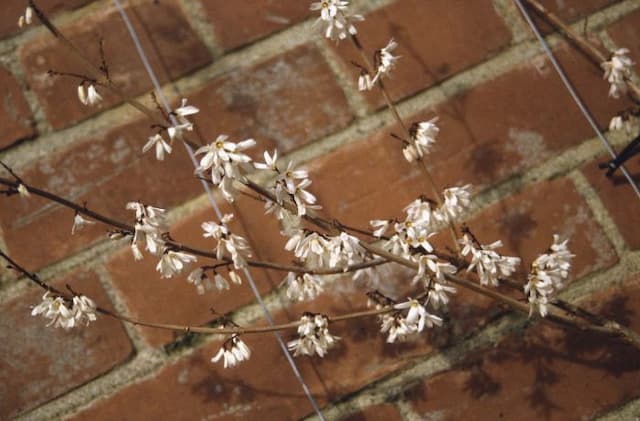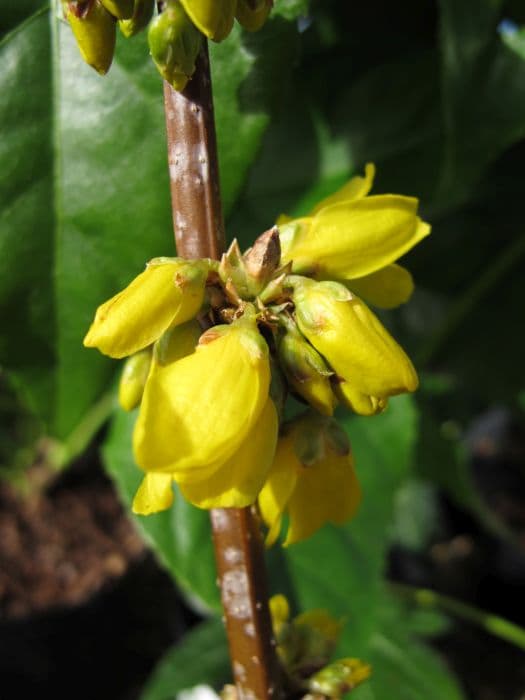Dwarf Korean Lilac Syringa meyeri 'Palibin'

ABOUT
The Syringa meyeri 'Palibin', commonly known as the Dwarf Korean Lilac, is a visually appealing ornamental shrub that captivates with its abundance of fragrant blooms. The most striking feature of this plant is its stunning flower panicles, which consist of tiny, densely packed purple buds that open to reveal an array of delicate, pale lavender to pinkish- purple flowers. These sweetly scented blossoms not only add a splash of color but also attract butterflies and bees to the garden. The leaves of Dwarf Korean Lilac are small and rounded with a slightly heart-shaped base, presenting a fresh, deep green hue that contrasts beautifully with the light-colored blooms. During the fall, the foliage may turn to a graceful array of soft, muted tones before shedding. This lilac variety offers a compact, round, and very neat overall form, making it an ornamental choice that brings both visual interest and a pleasant aroma to any landscape.
About this plant
 Names
NamesFamily
Oleaceae
Synonyms
Dwarf Korean Lilac, Meyer Lilac, Palibin Lilac
Common names
Syringa meyeri 'Palibin'.
 Toxicity
ToxicityTo humans
Dwarf Korean Lilac, which is the common name for Syringa meyeri 'Palibin', is not considered highly toxic to humans. However, like many plants, it may cause some degree of discomfort if ingested, potentially resulting in gastrointestinal upset, such as nausea or vomiting. Plant parts may also act as an irritant on contact with skin for sensitive individuals. It is generally advisable to avoid eating parts of ornamental plants due to the potential risks and lack of edibility.
To pets
Dwarf Korean Lilac is generally not regarded as highly toxic to pets either. However, if a pet were to ingest a significant amount of the plant, they might experience symptoms similar to those in humans, such as gastrointestinal upset, which could manifest as vomiting or diarrhea. It's important to prevent pets from chewing on this plant to avoid any potential negative effects. Always consult a veterinarian if you suspect your pet has ingested any potentially harmful substance.
 Characteristics
CharacteristicsLife cycle
Perennials
Foliage type
Deciduous
Color of leaves
Green
Flower color
Pink
Height
4-5 feet [1.2-1.5 meters]
Spread
5-7 feet [1.5-2.1 meters]
Plant type
Shrub
Hardiness zones
3-7
Native area
China
Benefits
 General Benefits
General Benefits- Compact Size: 'Palibin' is a dwarf lilac, making it suitable for small gardens or limited spaces.
- Low Maintenance: It requires minimal pruning and care once established.
- Attractive Blooms: Offers abundant pink-lavender flowers that are fragrant and attract pollinators like butterflies and bees.
- Hardy Nature: It is resistant to common diseases and pests, and can tolerate cold climates.
- Long Blooming Period: Flowers in late spring and often reblooms lightly throughout the summer.
- Deer Resistant: Less likely to be damaged by deer compared to other garden plants.
- Fall Interest: The leaves often turn to attractive shades of red or burgundy in the fall.
 Medical Properties
Medical PropertiesThis plant is not used for medical purposes.
 Air-purifying Qualities
Air-purifying QualitiesThis plant is not specifically known for air purifying qualities.
 Other Uses
Other Uses- Syringa meyeri 'Palibin', commonly known as dwarf Korean lilac, can be utilized in bonsai cultivation due to its compact growth habit and attractive foliage.
- The plant's dense branches can provide shelter for small wildlife and beneficial insects, creating a microhabitat within a garden ecosystem.
- With its pleasant fragrance, the blossoms can be used in making potpourri or scented sachets for drawers and closets.
- The dwarf Korean lilac can be planted as part of a themed garden, such as a 'moon garden', where its light-colored flowers are particularly visible in the evening.
- The branches, when pruned, can be used in floral arrangements to add structure and a springtime appeal to indoor bouquets.
- It can serve as a natural dye source, with the flowers potentially providing color for fabrics or crafts.
- The wood from mature stems can be carved into small items or used in making craft projects due to its hard, dense nature.
- The leaves can be used to create leaf mould, a type of compost that provides excellent nutrients and improves soil structure when added to garden beds.
- The blossoms can be infused into oils or vinegars to capture the delicate lilac scent and flavor for culinary experiments, such as dressings and marinades.
- It can be planted as a living fence or privacy screen that not only blocks unwanted views but also adds ornamental value to the landscape.
Interesting Facts
 Feng Shui
Feng ShuiThe Lilac is not used in Feng Shui practice.
 Zodiac Sign Compitability
Zodiac Sign CompitabilityThe Lilac is not used in astrology practice.
 Plant Symbolism
Plant Symbolism- Youthful Innocence: Syringa meyeri 'Palibin', commonly known as Dwarf Korean Lilac, often symbolizes the carefree and innocent days of youth, reminiscent of its delicate, early blooms in spring.
- First Love: The light and fresh fragrance of the Dwarf Korean Lilac is associated with the sweet and unforgettable emotions of one's first love.
- Renewal: As a harbinger of spring, Dwarf Korean Lilac represents renewal and the rebirth of nature after the dormant winter season.
- Beauty: The attractive blossoms and the plant's compact, rounded shape signify beauty, both physical and aesthetic.
- Nostalgia: The intoxicating scent of the Dwarf Korean Lilac can trigger memories of past springs, symbolizing nostalgia and the connection to good times gone by.
 Water
WaterThe Dwarf Korean Lilac (Syringa meyeri 'Palibin') should be watered regularly to keep the soil consistently moist but not waterlogged, especially during its first growing season to establish a deep root system. Once established, it requires less frequent watering, but it's important to water it during periods of drought or extreme heat. Generally, watering should be done deeply, providing about 1 inch of water per week, whether from rainfall or manual watering. Adjust the frequency to meet the plant's needs based on soil conditions and weather – more frequent watering in hot, dry conditions and less when it's cool or rainy.
 Light
LightThe Dwarf Korean Lilac prefers full sun to partial shade, ideally receiving at least 6 hours of direct sunlight per day for optimal bloom and growth. An ideal spot would be one that gets bright, unfiltered sunlight for most of the day, although the plant can tolerate some light shade, particularly in the afternoon when sunlight can be more intense.
 Temperature
TemperatureDwarf Korean Lilacs are cold-hardy and can tolerate winter temperatures as low as -30°F, with an ideal growing range between 60°F and 75°F during the growing season. They can survive temporary spikes above this range, but prolonged heat above 85°F can stress the plant. Ensure it's planted in a zone that matches its hardiness for best results, typically USDA zones 3 through 7.
 Pruning
PruningDwarf Korean Lilacs should be pruned immediately after blooming to shape the plant and remove spent flowers, which encourages more blooms for the following year. Pruning can be done annually to maintain a compact shape and remove any dead or diseased wood. The best time for pruning is late spring or early summer, after the plant finishes flowering. Avoid late summer or fall pruning, as it can cut off next year's buds.
 Cleaning
CleaningAs needed
 Soil
SoilThe Dwarf Korean Lilac prefers well-drained, fertile soil with a pH of 6.5 to 7.0. A great soil mix would be equal parts garden soil, well-rotted compost, and coarse sand to ensure good drainage.
 Repotting
RepottingDwarf Korean Lilacs do not require frequent repotting and can typically thrive in the same pot for several years. It's best to assess the root system every 3-4 years and repot if necessary.
 Humidity & Misting
Humidity & MistingThe Dwarf Korean Lilac tolerates average outdoor humidity levels and does not require any special humidity adjustments.
 Suitable locations
Suitable locationsIndoor
Ensure bright light and cool temperatures for indoor Dwarf Korean Lilac.
Outdoor
Plant Dwarf Korean Lilac in full sun, sheltered from strong winds.
Hardiness zone
3-7 USDA
 Life cycle
Life cycleDwarf Korean lilac (Syringa meyeri 'Palibin') begins its life as a dormant seed, which upon germination in suitable conditions, sprouts into a seedling. The seedling stage involves the initial formation of roots and shoots, which then develop into a young plant with characteristic leaves. As the plant matures into an established shrub, it undergoes vegetative growth, producing woody stems and a fuller shape. During its reproductive stage, usually in late spring to early summer, the Dwarf Korean lilac enters full bloom, showcasing clusters of fragrant purple flowers that attract pollinators. Following pollination, the flowers develop into seed capsules that eventually dry and release new seeds for the next generation. The shrub may have a lifespan of several decades, during which it will enter a phase of maturity, followed by a gradual decline in vigor until it reaches the end of its life cycle.
 Propogation
PropogationPropogation time
Spring-Early Summer
The Dwarf Korean Lilac (Syringa meyeri 'Palibin') is commonly propagated through softwood cuttings taken in late spring to early summer. This process involves selecting a healthy, non-flowering shoot and cutting a 4 to 6-inch (10 to 15 cm) length, making sure the cutting has at least 3-5 sets of leaves. The bottom set of leaves are removed, and the cut end is dipped in a rooting hormone to encourage root development. The cutting is then inserted into a pot filled with a moist, well-draining soil mix. The pot should be placed in a bright, indirect light location and kept consistently moist but not waterlogged. Roots typically develop in a few weeks, after which the new plant can be gradually acclimatized to outdoor conditions before planting in its permanent location.









